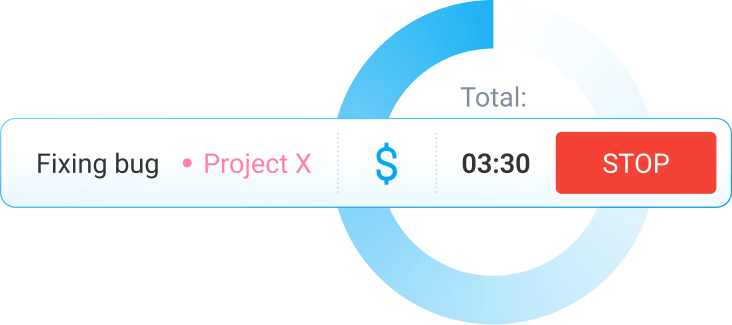Work-Life Balance Statistics for 2025: Global Trends
How important is work-life balance to you? Would you accept less money for a position that guarantees a healthier balance between your work and private life?
People worldwide are becoming increasingly aware of the importance of maintaining a healthier work attitude.
In this article, we present essential work-life balance statistics to underscore the critical role a healthy routine plays in today’s world.

What is work-life balance?
According to the Cambridge dictionary, work-life balance is “the amount of time you spend doing your job compared with the amount of time you spend with your family and doing things you enjoy.”
Also, as the article from the International Journal of Psychological Studies states, work-life balance (WLB) can be viewed as “finding the right amount of time for both your job and personal life, ensuring neither one takes over completely.”
Simply put, it refers to the ability to separate work from personal life.
When people achieve a good work-life balance, they make their physical, emotional, and mental health a priority.
However, when work takes up too much of their time and energy, they often struggle to find time for their personal lives. This imbalance can lead to conflicts between job responsibilities and family life, ultimately affecting their overall well-being. Here are some benefits of adequate WLB:
- It promotes mental well-being,
- It stimulates positive emotions,
- It leads to increased motivation, and
- It improves job satisfaction, which consequently betters job performance and organization.
🎓 Work-life balance & time tracking: Alex Beadon interview
What is the quality of work life?
Quality of work life (QWL) refers to how well a company meets its employees’ needs. Companies can do so by creating systems that let their staff have a say in decisions and manage their work more effectively, studies state.
High QWL helps improve WLB as it can reduce stress as well as boost job satisfaction and commitment.
For decades, personal growth and motivation have been at the core of the definitions of quality of work life. It is believed that an organization is most successful when employees are satisfied with their jobs.
Take a look at 10 crucial work-life balance statistics that showcase its importance for workers worldwide:
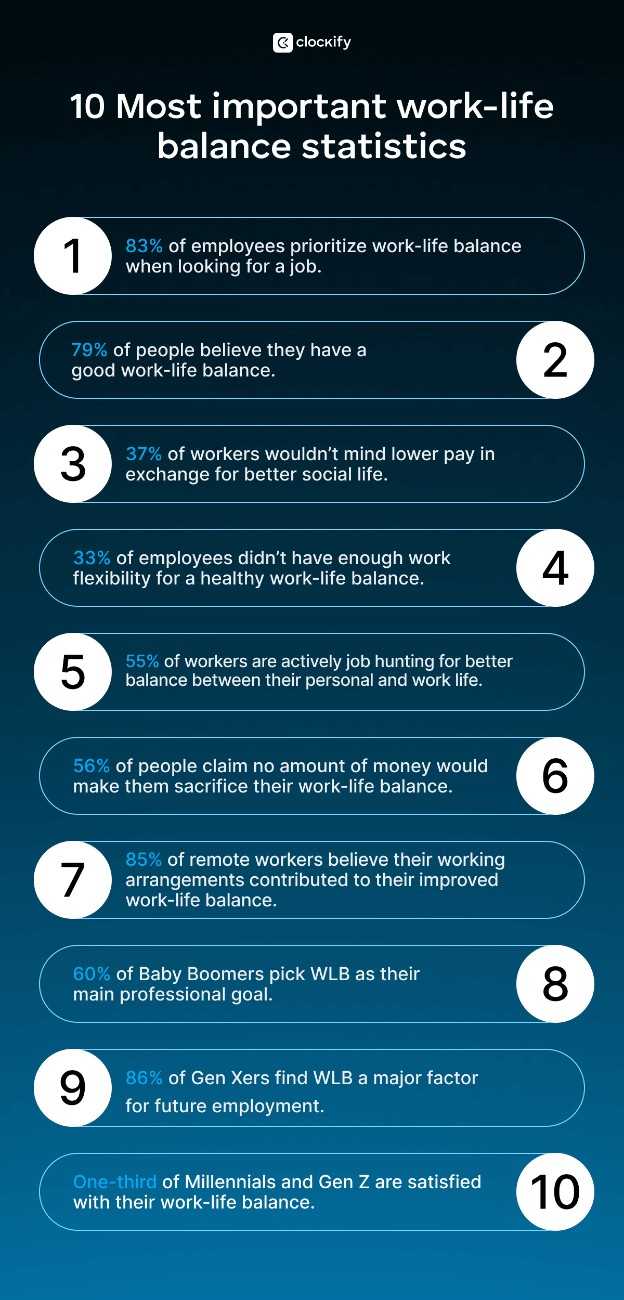
The importance and benefits of work-life balance
Work-life balance affects both employees’ performance and their well-being.
In this section, we’ll find out more about:
- How important workers believe achieving this balance is,
- What are the main benefits of work-life balance, and
- How many people continue to struggle with striking that harmony between work and life.
What percentage of people value a work-life balance?
The state of work-life balance around the world was explored in a 2025 Workmonitor report by Randstad, a global recruitment company.
The report showed that 79% of workers say they have a good work-life balance.
Moreover, a new workplace paradigm has emerged. For the first time in Workmonitor’s 22-year history, work-life balance has surpassed employee pay in importance.
Here are Randstad’s findings in a nutshell:
- 83% of employees prioritize WLB (compared to 82% who prioritize pay),
- 56% of respondents would trust employers more if they had personalized work benefits and work flexibility, and
- 37% of people wouldn’t mind lower earnings if their work allowed for a richer social life.
Moreover, research by The Muse found that work-life balance is crucial for most workers. The survey first explored the ways people describe work-life balance. It provides insight into what’s important to employees regarding the relationship between their private lives and the workplace.
According to 51% of respondents, work-life balance means “having the flexibility and autonomy to pivot to personal needs when they arise during a workday or week.”
The second-most popular answer for the work-life balance definition, chosen by 23% of employees, was “the amount of time I spend at work/job does not interfere with the amount of time spent on my personal life.”
Like Randstad, The Muse also found that 83% of survey participants would take a job that pays less if the job provided them with a better work-life balance.
In addition, 56% of respondents value work-life balance so much that no amount of raise would get them to sacrifice their work-life balance.
What are the main benefits of a good work-life balance?
In this 2025 research from Jurnal Economia, work-life balance is shown to have immense benefits for employees. The study found that a balance between work and private life has a positive effect on:
- Job performance, and
- Job satisfaction.
The study also indicated that poor work-life balance leads to:
- Reduced productivity, and
- Poor employee performance.
Moreover, a 2024 qualitative study of how WLB influences different employee attitudes listed the following benefits of learning how to balance work and life:
- Better job performance,
- Higher job satisfaction,
- Increased organizational commitment, and
- Higher life and family satisfaction.
In addition, the same study has shown that work-life balance lowered the chances of suffering from detrimental consequences of stress, such as:
- Emotional exhaustion,
- Anxiety, and
- Depression.
🎓 Career burnout and its effect on health
How many people are struggling with work-life balance?
A report from 2024, the CIPD Good Work Index, explored how work affects the personal lives of UK workers. Here are the main findings:
- 56% of workers said that work didn’t affect their personal commitments, while 24% disagreed.
- 42% of respondents felt exhausted at work, while 37% reported struggling with work pressure.
- 25% of people reported negative physical and mental health impacts from work.
- 22% of employees left their previous jobs due to insufficient work-life balance.
Furthermore, the American Psychological Association’s (APA) 2024 Work in America survey inspected psychological safety in the workplace and found that:
- 33% of workers didn’t have enough flexibility at work to maintain a healthy work-life balance.
- 45% of employees worked more hours per week than they’d like.
- 60% of workers felt their company truly respects time off.
Thus, despite being valued by the majority of employees, many people around the world still face work-life balance issues.
🎓 Improve Employee Morale With These 4 Tips
Work-life balance statistics in different types of work settings
Your WLB is highly dependent on your work environment, which can be:
- Remote work environment,
- On-site setting,
- Hybrid work arrangement, or
- Flexible work schedule.
Flexible working implies that you set your own work hours, and you get to choose where you will do your tasks — in the office, at home, or anywhere else.
According to the 2024 survey on changing jobs, employees value work-from-home options, flexibility, and work-life balance more than ever. Namely, 65% of workers prefer a fully remote job, while 34% favor a hybrid setup.
In fact, remote work was ranked as the most important factor people consider when choosing a job (81% of respondents). Furthermore, 72% of respondents chose a flexible schedule, while 61% opted for work-life boundaries.
🎓 Return-To-Office Mandates: Pros, Cons, and Best Approach
Effects of work settings on WLB
Additionally, Owl Labs’ 2024 State of Hybrid Work report uncovered more interesting work trends, including:
- 72% of hybrid and fully remote workers say they’re less likely to take a sick day and put work aside to rest when ill.
- 55% of workers are seeking new job opportunities for better WLB.
- 41% of people would look for a new job if they lost their hybrid work setting privilege.
- 84% of hybrid and remote workers tend to eat healthier food when working from home compared to the office.
- 47% of full-time office employees are 2x as likely to exercise during the workday than their remote peers (22%).
- 90% of hybrid workers claim they are equally (or more) productive when working in a hybrid model.
- 77% of remote/hybrid workers feel they have the flexibility to manage both work and life.
- When balancing work and life, 51% of workers feel most productive when working from home, followed by 30% in-office and 19% in a coworking space.
- 85% of workers spend up to 45 minutes commuting each way — time that can be spent on other more meaningful activities that contribute to WLB.
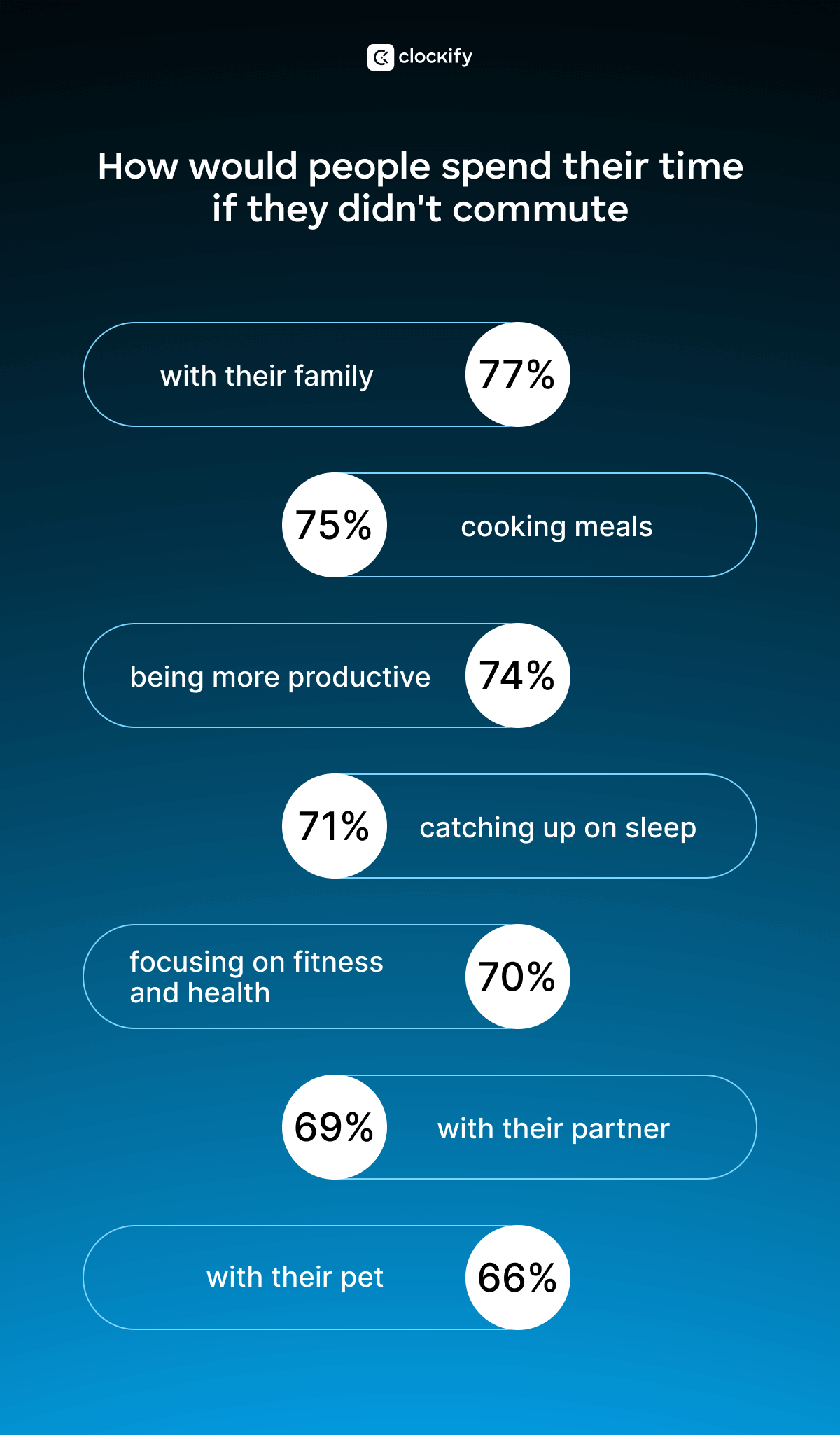
Also, PwC’s 2024 Workforce Radar report reveals that 48% of employees who can’t work remotely due to the nature of their job find their work schedules flexible enough to fully enjoy their personal time.
It’s important to consider the positive and negative effects of different work settings. Before deciding on the right model for your company, account for employees’ well-being, work-life balance, and the nature of the jobs.
🎓 Hybrid Work Schedule: How To Make It Work
Impact of flexible working on WLB
When it comes to good work-life balance, flexible work schedules (remote and hybrid) definitely seem to be favorable.
According to Gallup research, 5 in 10 full-time workers in the US have jobs that can be performed remotely. Moreover, 76% of hybrid workers report improved work-life balance as the biggest perk of their work arrangement. At the same time, 85% of fully remote employees find that their flexible working schedule greatly benefits theirWLB.
According to a recent SSRN paper on flexible working, such working arrangements lead to the employees’ improved:
- Performance and productivity,
- Relationship with the employer,
- Morale and well-being, and
- Work-life balance.
One survey about remote work among women and men discovered that a significant 82% of professionals said their mental health is better when working remotely than on-site. This number further breaks down to 84% for women and 77% for men.
What’s more, another research on workplace perspectives of a multigenerational workforce found that the benefits of flexible work, from improved job satisfaction to WLB, are desirable across generations. Precisely, this is how many choose work-life balance as their main professional goal:
- 85% of Millennials,
- 81% of Gen X, and
- 60% of Boomers.
Speaking of generational differences, let’s touch upon that in more detail.
Work-life balance statistics and different generations
Let's examine what work-life balance means to 4 different generations — according to this PMP article:
- Baby Boomers (born 1946-1964) value stability over flexibility,
- Gen X (born 1965-1980) seeks flexibility and adaptability,
- Millennials (born 1981-1996) look for purpose and fulfillment, and
- Gen Z (born 1997-2012) puts flexibility and mental health first.
Baby Boomers are used to long work hours and typically prioritize providing for their families over having flexible work arrangements. Their idea of balance leans more toward ensuring a steady income rather than adjusting work schedules for personal time.
Gen Xers were among the first to see WLB become a major workplace issue. They value flexible work arrangements and often look for ways to blend their professional and personal lives.
Millennials don’t just want a job — they want a career that aligns with their values and lifestyle. They emphasize work-life balance by seeking flexible schedules, remote work, and jobs that provide a sense of purpose.
Gen Zs expect employers to offer adaptable work environments, including remote options and mental wellness initiatives. They prioritize work that aligns with their values and offers opportunities for growth, making work-life balance a non-negotiable part of their career choices.
Generational statistics about work-life balance
Based on the said Randstad’s Workmonitor study, work-life balance was (one of) the most important factors for workers’ current job and/or future employment:
- Boomers — 85%,
- Gen X — 86%,
- Millennials — 83%, and
- Gen Z — 74%.
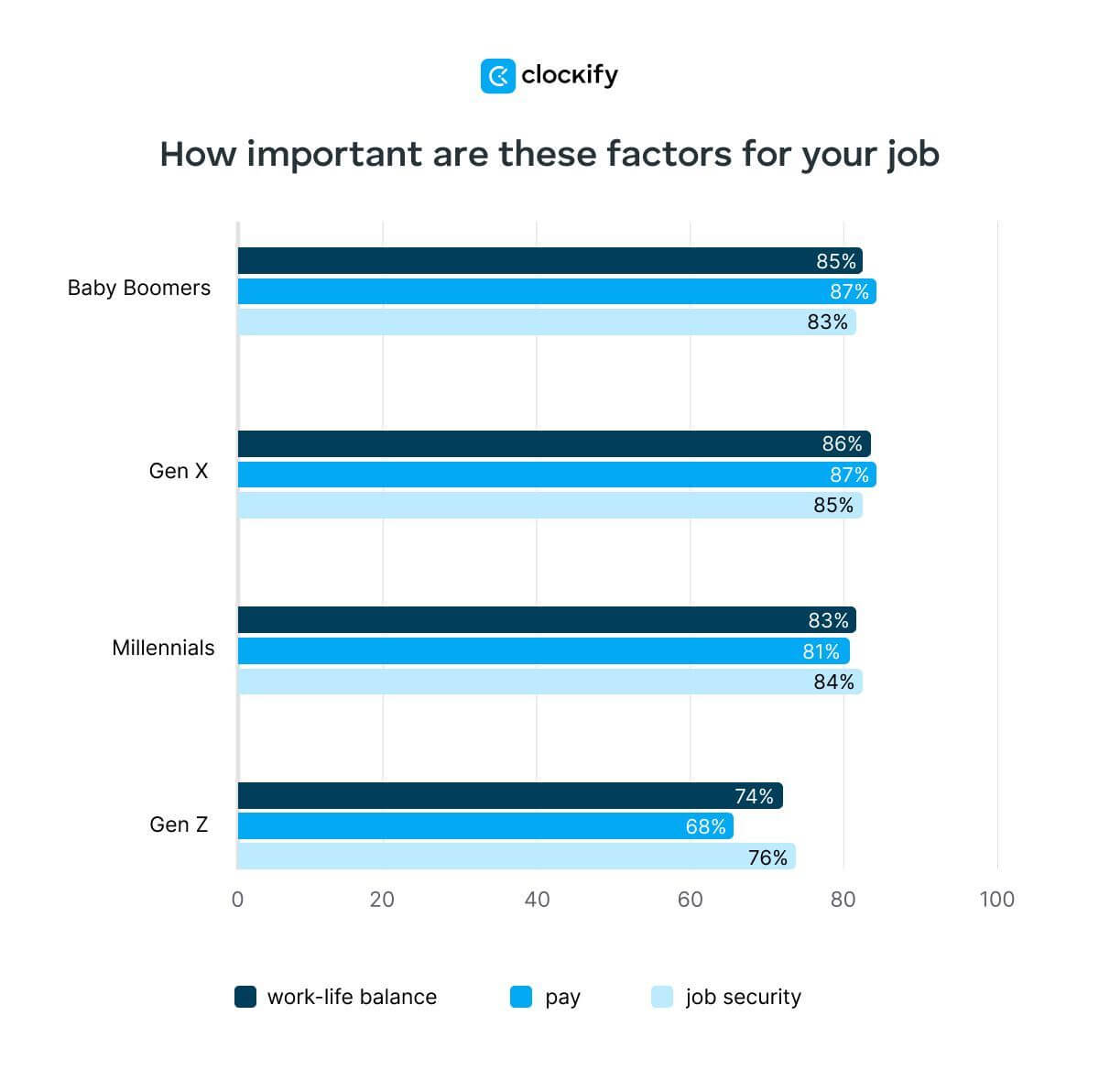
It seems that Boomers are becoming more aware of their need (and right) for a good WLB. However, the results for the percentage of people who decided to quit because their jobs didn’t fit their personal lives still show clear generational differences:
- Boomers — 28%,
- Gen X — 34%,
- Millennials — 42%, and
- Gen Z — 43%.
Furthermore, Deloitte’s 2024 Gen Z and Millennial Survey revealed that poor work-life balance causes serious stress and anxiety for 34% of Gen Zs and 30% of Millennials. The results for groups who were actually satisfied with their WLB were on the lower side — 37% of Gen Zs and 34% of Millennials.
For this group of respondents, good WLB was the reason why they chose their organization in the first place for 25% of Gen Zs and 31% of Millennials. On the other hand, 13% of Gen Zs and 14% of Millennials left their previous organization due to insufficient work-life balance.
It’s also interesting to observe overtime work hours across generations. According to CAKE.com’s 2024 State of Workplace Culture and Work-Life Balance Trends report, 9.51% of Gen Zs (18-24 years old) log 15+ hours of overtime every week (40-hour workweek).
When it comes to Millennials (35-44 years old), that percentage falls to 8.80%. Additionally, 11.08% of Boomers (over the age of 65) log more than 15 hours of weekly overtime, with the highest percentage for Gen Xers (45-54 years old) — 12.06%.
Work-life balance statistics around the globe
Another area we’d like to discuss in this article is how your location can impact your work-life balance. Since the average working hours per country can vary across the globe, your WLB might highly depend on your location.
OECD countries and work-life balance statistics
The Organisation for Economic Co-operation and Development (OECD) includes 38 countries: Australia, Austria, Belgium, Canada, Chile, Colombia, Costa Rica, Czech Republic, Denmark, Estonia, Finland, France, Germany, Greece, Hungary, Iceland, Ireland, Israel, Italy, Japan, Korea, Latvia, Lithuania, Luxembourg, Mexico, The Netherlands, New Zealand, Norway, Poland, Portugal, Slovak Republic, Slovenia, Spain, Sweden, Switzerland, Turkey, UK, and USA.
According to the latest official OECD numbers (across the 22 OECD countries studied), an average employee spends 63% of their day on leisure and personal care. That amounts to 15 hours each day. Men and women devote about the same number of hours to personal care and leisure.
Personal care involves eating and sleeping, while leisure time includes:
- Socializing with friends and family,
- Computer and TV use,
- Games, and
- Hobbies.
Official stats also show that 10% of employees work 50 or more hours every week. Countries with alarmingly high numbers regarding 50+ working hours a week are:
- Mexico, with 27% of employees,
- Turkey, with 25%, and
- Colombia, with 24%.
In general, men work very long hours more commonly than women. According to official numbers, 14% of male workers and 6% of female employees work 50+ hours a week.
🎓 Time Management Statistics Everyone Should Know in 2025 (And Beyond)
Teleworking and work-life balance in OECD countries
According to official OECD research, employees working in companies with teleworking policies report better:
- Life satisfaction,
- Work-life balance,
- Mental health, and
- Physical health.
The same research shows that 79% of employees who were consulted about their company's teleworking policy are happy with their work-life balance. On the other hand, 62% of workers who weren't consulted about their company's remote work policy share the same feeling.
Thus, teleworkers in OECD countries report better work balance than those working in offices. In addition, companies consulting their employees about their ideal teleworking policies have higher levels of employee satisfaction.
🎓 How to Create a Remote Work Schedule (with Templates)
Statistics on the highest work-life balance levels in the world
An international recruiting platform, Remote, came up with the Global Life-Work Balance Index to explore the state of work-life balance in 60 states with the highest GDP in the world.
This index examines factors essential for a good work-life balance, such as:
- Annual leave,
- Maternity and sick leave and pay,
- Minimum wage,
- Healthcare,
- Average hours worked per week,
- Inclusivity, and
- Overall happiness.
With a score of 80.76/100, New Zealand is the state with the highest level of work-life balance. The rest of the list of countries with the best work-life balance goes as follows:
- Ireland,
- Belgium,
- Denmark,
- Canada,
- Germany,
- Finland,
- Australia,
- Norway, and
- Spain.
With its strict workplace policies, the United States ranks among the lowest with regard to work-life balance, ranking 55th out of 60 countries on the list.
Additionally, Remote’s research on the best industries for work-life balance in the US found that Finance and Insurance score first with 7.97/10. This is followed by:
- Education,
- Architecture and Engineering,
- Information and Communication, and
- Real Estate.
Health implications of work overload
According to FlexJobs’ 2024 Workforce Wellness Report, 28% of workers feel pressured to overwork every day. As a result, a significant 70% of employees believe companies should rethink the traditional 40-hour workweek. Namely, 89% of employees want 4-day workweeks and compressed schedules.
🎓 Everything You Need to Know About the 4-Day Workweek Concept
According to the Occupational Safety and Health Administration (OSHA), a normal work shift shouldn’t involve more than 8 consecutive hours of work, 5 days a week, with a mandatory 8-hour rest period.
Essentially, extended working hours (beyond the traditional 40 hours a week) can lead to many health issues, such as workplace stress, fatigue, poor concentration, digestive problems, headaches, depressed mood, etc.
About 45% of workers say they work more hours per week than they’d like. This issue is even more pronounced for those with cognitive, emotional, learning, or mental disabilities, affecting 57% of them, as per the APA survey.
Thanks to the Family and Medical Leave Act (FMLA), eligible employees can take 12 workweeks of unpaid leave annually for family/medical reasons, which means a lot for those with caregiving responsibilities.
Also, the Americans with Disabilities Act (ADA) allows for adequate workplace accommodations for workers with a disability. In the US, 18% of the workforce report some mental health problems monthly, making psychiatric disability the most common ADA-covered disability. However, job-related stress doesn’t fall into this category.
The wellness report above found that 80% of respondents had to put up with a toxic work environment just to keep their jobs. One of the main stressors included excessive workload (34%) and poor work-life boundaries (24%).
The link between work-life balance and employee turnover
Work-life balance affects job satisfaction. A 2024 study from the SA Journal of Human Resource Management found a direct link between WLB and turnover intentions.
Essentially, poor WLB can lead to job dissatisfaction, making employees feel disengaged and unmotivated. As a result, many workers decide to leave their jobs in search of roles that offer greater fulfillment and a healthier balance of work and personal life.
Similarly, CIPD’s report found that 20% of respondents were likely to leave their current organization in the next year due to poor work conditions that also affected their WLB.
Similar findings were reported by FlexJobs as well. The top workplace trend identified was quiet quitting — 20% of employees reported disengaging from work before officially leaving.
As mentioned, Randstad found that work-life balance has become a top priority for job seekers, with 83% considering it a key factor in their current or future job — right alongside job security.
Interestingly, psychological safety at work doesn’t guarantee that the conditions for effectively balancing personal and professional lives are met. Still, problems with WLB are significantly lower among those who feel higher levels of psychological safety at work, according to APA.
That said, 18% of people who feel high levels of psychological safety at work still reported difficulties balancing their work and life, as opposed to 50% of those who feel lower psychological safety.
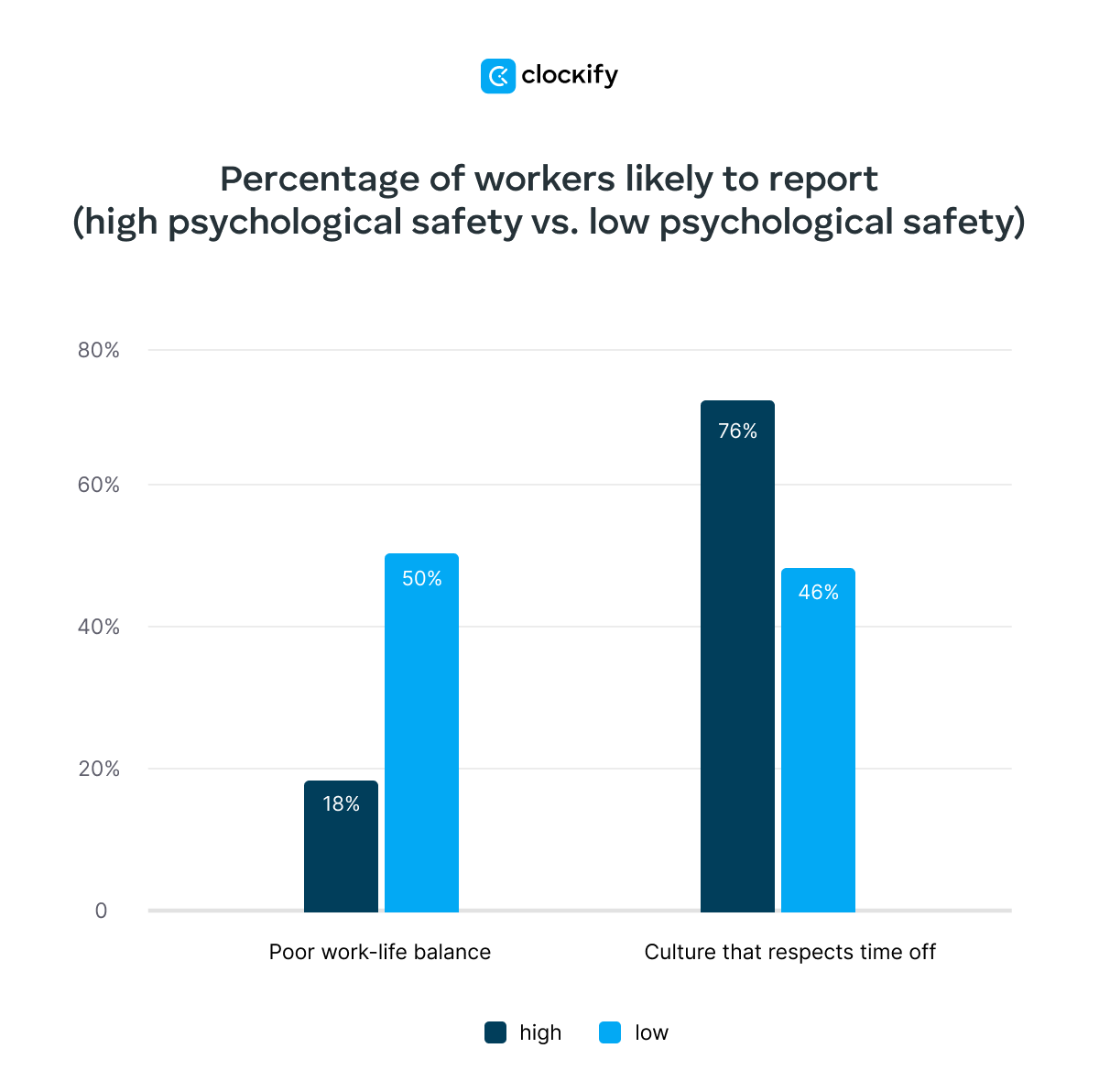
Among workers planning to job hunt within the next year, only 43% feel their current workplace has a culture that truly respects time off.
🎓 4 Signs an Employee Is About to Quit + 3 Retention Strategies
Strategies for improving work-life balance
For many, achieving a healthy WLB feels impossible. Between heavy workloads, family responsibilities, and personal commitments, stress can quickly take over. In fact, more than 1 in 4 Americans report feeling “super stressed,” according to Mental Health America.
The good news? Balance is achievable.
As an employee in need of an improved work-life balance, consider the following tips at work:
- Set realistic goals. Workload management and task prioritization prevent stress and boost a sense of control.
- Use your time wisely. Break big tasks into smaller steps and reward yourself for progress.
- Ask for flexibility. Many companies now offer remote work options and flexible hours, so feel free to inquire.
- Take breaks. Short pauses improve focus and reduce stress. A longitudinal study about vacation and creativity found that workers who take regular breaks display 20% more productivity and 15% more creativity.
- Communicate effectively. Be honest with your boss or team about challenges, and don't hesitate to set availability expectations.
And at home:
- Allow yourself to unplug. Set boundaries between work and personal time.
- Share responsibilities. Divide household tasks fairly to reduce stress.
- Stay active. Exercise helps manage stress, improves health, and boosts energy.
- Seek support. Talk to friends, family, or professionals if stress becomes overwhelming.
How employers can support WLB
A healthy work-life balance benefits both employees and businesses. Here are 8 ways employers can help their teams find that balance, according to WebMD:
- Lead by example. When managers show healthy boundaries, like avoiding late-night emails, employees feel empowered to do the same.
- Ditch the always busy mentality. Productivity isn’t about working nonstop. Encourage employees to set boundaries around work hours and provide mental health resources.
- Cut unnecessary meetings. Not every discussion needs a meeting. Consider alternatives like quick check-ins or shared documents.
- Support working parents. Family-friendly policies like flexible hours, childcare support, and parental leave reform help retain top talent.
- Encourage a fake commute. A short morning walk or coffee run can create a healthy transition between work and personal time for remote workers.
- Bring back lunch breaks. Stepping away from work, even for 30 minutes, can improve focus and reduce burnout.
- Offer workplace flexibility. Flexible scheduling, compressed workweeks, and remote work options give employees control over their time.
- Make PTO easier to take. Reduce the stress of taking time off by offering transition days before and after vacations.
At the core of these strategies is a simple idea — work should fit into life, not the other way around.
Use digital tools to enhance your work-life balance: Clockify, Plaky, and Pumble
When you’re happy with your work life, your productivity and performance will thrive. As a result, your overall work-life quality will be enhanced, too.
But finding the right work-life balance is just as important as having a high-quality work life.
- Plaky for managing tasks efficiently,
- Pumble for communicating with coworkers effectively, and
- Clockify for tracking time and preventing overwork.
These 3 powerful tools are designed to improve workplace efficiency while promoting balance.
With the right tools, work-life balance becomes a reality, not just an aspiration!
